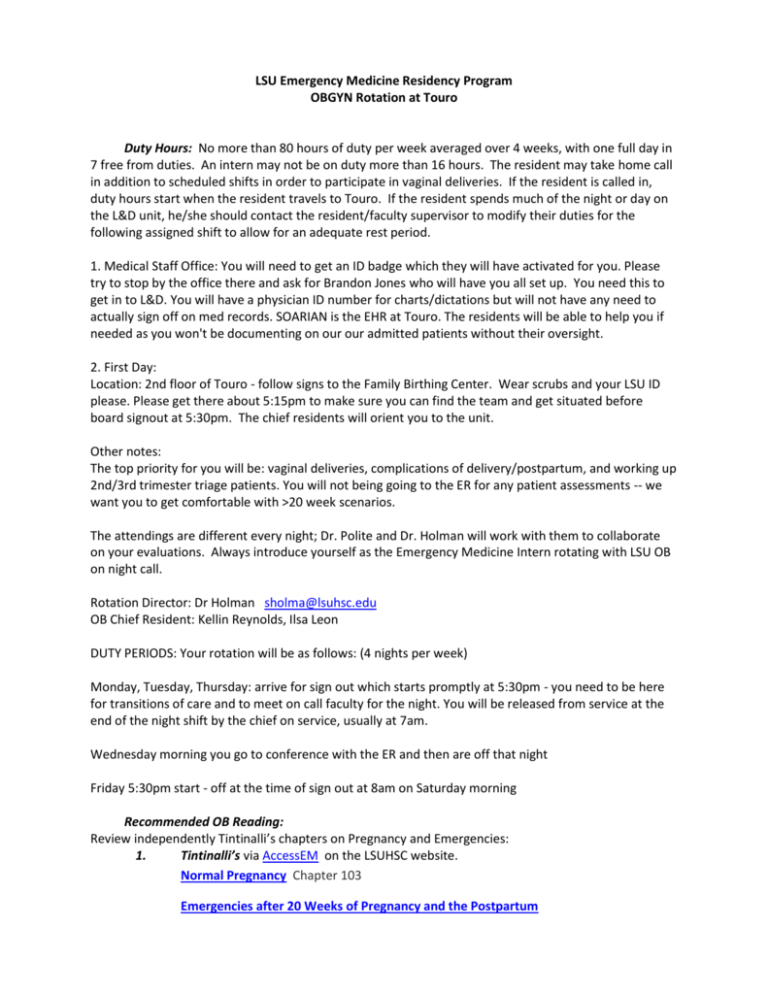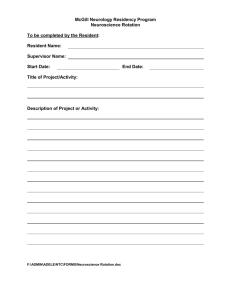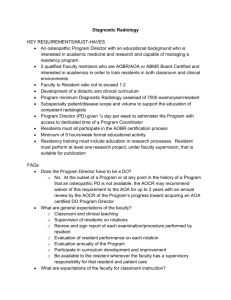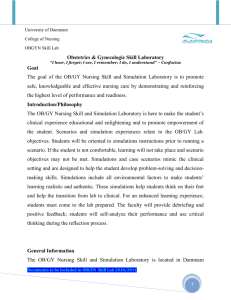Model Curriculum for Emergency Medicine Residency Training
advertisement

LSU Emergency Medicine Residency Program OBGYN Rotation at Touro Duty Hours: No more than 80 hours of duty per week averaged over 4 weeks, with one full day in 7 free from duties. An intern may not be on duty more than 16 hours. The resident may take home call in addition to scheduled shifts in order to participate in vaginal deliveries. If the resident is called in, duty hours start when the resident travels to Touro. If the resident spends much of the night or day on the L&D unit, he/she should contact the resident/faculty supervisor to modify their duties for the following assigned shift to allow for an adequate rest period. 1. Medical Staff Office: You will need to get an ID badge which they will have activated for you. Please try to stop by the office there and ask for Brandon Jones who will have you all set up. You need this to get in to L&D. You will have a physician ID number for charts/dictations but will not have any need to actually sign off on med records. SOARIAN is the EHR at Touro. The residents will be able to help you if needed as you won't be documenting on our our admitted patients without their oversight. 2. First Day: Location: 2nd floor of Touro - follow signs to the Family Birthing Center. Wear scrubs and your LSU ID please. Please get there about 5:15pm to make sure you can find the team and get situated before board signout at 5:30pm. The chief residents will orient you to the unit. Other notes: The top priority for you will be: vaginal deliveries, complications of delivery/postpartum, and working up 2nd/3rd trimester triage patients. You will not being going to the ER for any patient assessments -- we want you to get comfortable with >20 week scenarios. The attendings are different every night; Dr. Polite and Dr. Holman will work with them to collaborate on your evaluations. Always introduce yourself as the Emergency Medicine Intern rotating with LSU OB on night call. Rotation Director: Dr Holman sholma@lsuhsc.edu OB Chief Resident: Kellin Reynolds, Ilsa Leon DUTY PERIODS: Your rotation will be as follows: (4 nights per week) Monday, Tuesday, Thursday: arrive for sign out which starts promptly at 5:30pm - you need to be here for transitions of care and to meet on call faculty for the night. You will be released from service at the end of the night shift by the chief on service, usually at 7am. Wednesday morning you go to conference with the ER and then are off that night Friday 5:30pm start - off at the time of sign out at 8am on Saturday morning Recommended OB Reading: Review independently Tintinalli’s chapters on Pregnancy and Emergencies: 1. Tintinalli’s via AccessEM on the LSUHSC website. Normal Pregnancy Chapter 103 Emergencies after 20 Weeks of Pregnancy and the Postpartum Period Chapter 104 Emergency Delivery Chapter 105 2. 3. 4. 5. OTHER USEFUL SOURCES: Rosen’s Emergency Medicine: Concepts and Clinical Practice (5th ed.) Chapter 31: Trauma in Pregnancy Chapter 61: Sexual Assault Chapter 93: Genital Infections Volume Three, Part Five, Section II: The Pregnant Patient The Clinical Practice of Emergency Medicine, (3rd edition), Harwood-Nuss Section II, Part IX: Emergency Aspects of Obstetrics Roberts/Hedges: Clinical Procedures in Emergency Medicine (3rd ed.) Section 9: Ob/Gyn Procedures Prior to the start of the rotation, watch the OB ultrasound videos on the AccessEmergencyMedicine website (available through either the LSU library or the LSU EM residency webpage). OBJECTIVES: Gain expertise in the management of obstetrical and gynecological emergencies. Learn the priorities and procedures of labor and delivery. Become an integral part of the OBGYN team and respond to deliveries along with junior, senior, OBGYN staff and gain exposure to OR sterile techniques and surgical techniques. GOALS: The educational goals include gaining knowledge about the progression of normal labor, delivery and immediate post-partum care. The resident will also gain expertise in the initial management of gynecological emergencies. Participate in any teaching rounds Evaluate OBGYN patients in the L&D unit. Participate in OBGYN Procedures, both in the OR and in Labor and Delivery Participate in the routine care of OBGYN patients The clinical and didactic experiences used to meet those objectives included daily patient care of OBGYN patients, along with bedside teaching. The rotating resident is encouraged to attend lectures pertaining to the care of the OBGYN patient. This rotation experience is part of the greater emergency medicine curriculum, also including weekly didactics (part of the overall didactic curriculum). The feedback mechanisms and methods used to evaluate the performance of the resident include an end of rotation global evaluation. Immediate feedback may also be given to the resident, and any significant problems will be discussed during the rotation with the LSU EM administration. The resources and facilities in the institution that will be available to each resident include computer access to Up To Date and the LSU Library services, including current texts in OBGYN and emergency medicine. The residents will have access to the resources of the hospital including call rooms, the Medical Library, Hospital medical texts, medical records and the cafeteria. The clinical experiences, duties and responsibilities the resident will have on the rotation: Residents will act as a part of the OBGYN team under the supervision of a staff physician. The residents will participate in the initial management and care of OBGYN patients. The relationship that will exist between emergency medicine residents and faculty on the service: The overall goals of resident education and patient care will govern the relationship between faculty and residents. Residents will receive 24 hour supervision while on the rotation by upper level residents and OB faculty. All patient care and medical charts will be reviewed and signed by the OBGYN faculty daily and prior to patient discharge. Duty hours for this rotation will not exceed an average of 80hrs/week, call not longer than 16 consecutive hours and will include 1 in 7 days off. Obstetrics and Gynecology Core Competency-based Goals and Objectives Emergency Medicine Residency Training Program Curriculum Goal: Develop the ability to evaluate, stabilize, and treat OB patients in a manner consistent with the expectations of the knowledge and skills of an Emergency Physician. Objectives: 1. 2. 3. 4. Communicate effectively with patients, their families, and professional associates (*ICS). Demonstrate respect, compassion, and integrity (*PR). Demonstrate the ability to perform an appropriate history and physical exam (*PC). Demonstrate the ability to develop an appropriate differential diagnosis and treatment plan (*MK). 5. Demonstrate appropriate clinical decision making skills (*PC). 6. Learn the principles of fetal monitoring techniques (*PC). 7. Demonstrate the ability to perform a vaginal delivery (*PC). 8. Demonstrates the principles of basic ultrasonography (*PC). 9. Learn the basic resources available for the care of the obstetrical patient (*SBP). 10. Learn the appropriate information resources (i.e., textbooks, handbooks, online resources, etc.) available for care of obstetrical patient (*PBL). (* denotes core competency area: PC-patient care, MK-medical knowledge, ICS-interpersonal and communication skills, PR-professionalism, SBP-systems based practice, PBL-practiced based learning and improvement) Evaluation: 1. 2. 3. 4. 5. Daily verbal feedback by supervising OB/Gyn. Formal written evaluation of resident at end of rotation by Ob/Gyn, via the residency management software: New Innovations. Written evaluation of rotation by E.M. resident. Formal testing on annual ABEM in-service exam and departmental quizzes on topics addressed on rotation and didactics. Annual curriculum review by program director, faculty and residents. This rotation summary has been reviewed and agreed to by the service director and LSU Program Director and the OB-GYN Rotation Director at Touro.






